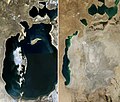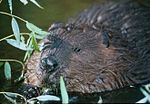In ecology, habitat refers to the array of resources, physical and biotic factors that are present in an area, such as to support the survival and reproduction...
53 KB (6,322 words) - 19:21, 17 September 2024
factors of spatial heterogeneity and habitat patchiness would later describe the conditions of a metapopulation relating to how groups of spatially separated...
14 KB (1,741 words) - 04:19, 22 August 2024
Spatial ecology studies the ultimate distributional or spatial unit occupied by a species. In a particular habitat shared by several species, each of the...
21 KB (2,432 words) - 01:24, 4 December 2023
Habitat destruction (also termed habitat loss and habitat reduction) occurs when a natural habitat is no longer able to support its native species. The...
64 KB (7,165 words) - 03:02, 14 September 2024
and spatial distribution of that habitat. Habitat restoration is a subset of habitat conservation and its goals include improving the habitat and resources...
36 KB (4,162 words) - 03:25, 3 August 2024
unique suitable habitats, more species can coexist in a landscape without competition, a phenomenon termed "niche partitioning." Spatial heterogeneity is...
12 KB (1,283 words) - 04:42, 28 January 2024
by some types of habitat fragmentation because they cannot respond quickly to the altered spatial configuration of the habitat. Habitat fragmentation consistently...
74 KB (8,598 words) - 05:20, 5 September 2024
Edge effects (redirect from Edge habitat)
surface instead.[citation needed] Ecotone Habitat fragmentation Landscape ecology Ruderal species Spatial ecology Woodland edge Levin, Simon A. (2009)...
17 KB (1,889 words) - 08:47, 25 July 2024
Marine spatial planning (MSP) is a process that brings together multiple users of the ocean – including energy, industry, government, conservation and...
21 KB (2,398 words) - 15:55, 10 July 2024
Homogeneity and heterogeneity (redirect from Habitat diversity)
the more common synonym in the context. Complete spatial randomness Heterologous Epidemiology Spatial analysis Statistical hypothesis testing Homogeneity...
14 KB (1,399 words) - 10:35, 14 September 2024
Patch dynamics (redirect from Habitat mosaic)
effect Forest dynamics Habitat conservation Habitat corridor Habitat fragmentation Island biogeography Landscape ecology Spatial ecology Pickett, Steward...
9 KB (1,051 words) - 23:22, 18 August 2023
Spatial politics is an interdisciplinary field that analyses the ways in which space and geographic location influence political processes, power relations...
20 KB (2,769 words) - 14:44, 26 May 2024
Landscape ecology (category Habitat)
favor the invasive's habitat requirements. Developments in landscape ecology illustrate the important relationships between spatial patterns and ecological...
46 KB (5,273 words) - 06:26, 12 July 2024
A Sustainable habitat is an ecosystem that produces food and shelter for people and other organisms, without resource depletion and in such a way that...
27 KB (2,998 words) - 03:14, 9 August 2024
Marine coastal ecosystem (redirect from Marine coastal habitat)
among habitats in the design of spatial management, there remain few examples where seascape connectivity is explicitly considered in spatial conservation...
197 KB (20,126 words) - 06:41, 17 September 2024
Agency (KCA) was established by UN-Habitat in 2000. It is the government agency under the Ministry of Environment and Spatial Planning. The KCA is the highest...
7 KB (830 words) - 09:29, 2 October 2023
Nocturnality (section Spatial disturbance)
their habitat. Carnivorous predators however are less timid of the disturbance, feeding on human waste and keeping a relatively similar spatial habitat as...
19 KB (2,370 words) - 11:57, 14 June 2024
The term Habitat I refers to the first United Nations Conference on Human Settlements, in Vancouver, British Columbia in Canada, 31 May – 11 June 1976...
6 KB (638 words) - 16:52, 4 August 2023
Giant panda (redirect from Giant panda habitat)
neighbouring Shaanxi and Gansu. Successful habitat preservation has seen a rise in panda numbers, though loss of habitat due to human activities remains its...
105 KB (10,941 words) - 07:53, 25 September 2024
Benthic zone (redirect from Benthic habitat)
in the deep sea. Because of their reliance on it, microbes may become spatially dependent on detritus in the benthic zone. The microbes found in the benthic...
20 KB (2,466 words) - 00:46, 25 September 2024
Marten (section Spatial niche segregation)
Andrzej (2015). "Spatial Niche Segregation of Sympatric Stone Marten and Pine Marten – Avoidance of Competition or Selection of Optimal Habitat?". PLOS ONE...
17 KB (1,294 words) - 06:33, 22 August 2024
Venanzoni, Roberto; Viciani, Daniele; Buffa, Gabriella (2016). "Habitats on the grid: The spatial dimension does matter for red-listing" (PDF). Journal for...
36 KB (4,515 words) - 14:30, 13 June 2024
Ecosystem engineer (redirect from Habitat engineer)
species that creates, significantly modifies, maintains or destroys a habitat. These organisms can have a large impact on species richness and landscape-level...
26 KB (2,869 words) - 12:29, 6 June 2024
In marine environments, a nursery habitat is a subset of all habitats where juveniles of a species occur, having a greater level of productivity per unit...
9 KB (1,276 words) - 01:28, 19 June 2024
species–area curve describes the relationship between the area of a habitat, or of part of a habitat, and the number of species found within that area. Larger areas...
9 KB (1,230 words) - 21:52, 4 February 2024
Geographic information system (section Spatial ETL)
decision-makers in analysing a set of alternative spatial solutions, such as the most likely ecological habitat for restoration, against multiple criteria,...
101 KB (13,118 words) - 10:22, 14 September 2024
Disturbance (ecology) (redirect from Disturbed habitat)
Because scale-dependent relationships are ubiquitous in ecology, the spatial scale modulates the effect of disturbance on natural communities. For example...
23 KB (2,712 words) - 15:54, 31 July 2024
Cougar (redirect from Puma habitat)
adaptable generalist species, occurring in most American habitat types. It prefers habitats with dense underbrush and rocky areas for stalking but also...
102 KB (10,594 words) - 18:06, 10 September 2024
the long-term probability of a species persisting in a given patch of habitat. Although population ecology is a subfield of biology, it provides interesting...
31 KB (3,551 words) - 16:12, 1 June 2024
confusalis are often quite large, and can contribute to epilithic spatial patchiness. Habitat degradation due to anthropogenic factors and climate change may...
5 KB (445 words) - 08:06, 13 August 2023
























